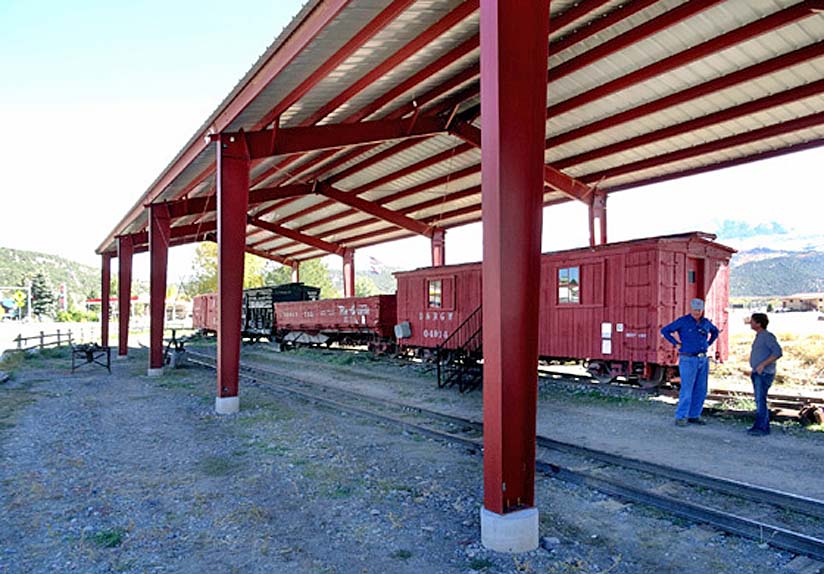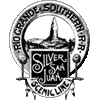
Ridgway Colorado USA - Colorado's Ridgway Railroad Museum sought a steel building system with a proven track record for their new rolling stock shelter.
After careful Internet research, museum officials decided a Rhino metal building was just the ticket.
Ridgway Railroad History
Nestled in a valley of the San Juan Mountains, Ridgway's scenic beauty drew settlers to the region, as did the area's rich silver mines.
Thanks to the early mining in the area, Ridgway also enjoys a unique place in American railroad history.
The first Colorado silver discovery was in the 1860s.
In 1879, a large silver strike in Leadville, Colorado, fueled the silver boom.
Soon other silver mines opened across the state, including those in the San Juan Mountains.
Moving supplies and silver ore through the rugged San Juan Mountains was tricky and treacherous.
A railroad seemed the best solution.
The Denver & Rio Grande Railroad (D&RG) laid branch lines to some Colorado mining towns.
However, the formidable Uncompahgre Gorge made connecting Silverton and Ouray seemingly impossible.
The Silverton Railroad finally managed to install tracks within eight miles of Ouray, but found no feasible way past that point.
In 1890, Otto Mears, founder of the newly christened Rio Grande Southern Railroad (RGS), began construction of a narrow gauge railroad line from Ridgway and Durango to the silver mining towns of Rico and Telluride.
Ridgway became the terminus between the D&RG and RSG lines.
A tribute to engineering and determination, the little-railroad-that-could completed the rail connections shortly before the great Silver Panic in 1893.
Silver prices plummeted to just 63 cents an ounce.
Many of the mines closed.
The railroads lost much of their expected traffic.
In 1951 the poverty-stricken RSG folded filing formal abandonment papers with the Interstate Commerce Commission.
Train Museum History
Karl Schaeffer grew up in nearby Montrose, Colorado.
After working with the Denver & Rio Grande Western Railroad for over 22 years, Karl and his wife Janet retired to Ridgway in 1997.
However, there is something about flying across country on those silver ribbons of steel that stays with a man.
Schaeffer's love of all things railroad led him to become one of the founders of the Ridgway Railroad Museum in 1998.
Today Schaeffer serves as the museum board president, and its biggest fan.
A non-profit organization, the Ridgway Railroad Museum seeks to share the rich history or railroading with area residents and visitors.
The museum's main focus is to educate people about the significance of the railroads to America's past.
Some of the documents displayed at the museum are over 100-years-old.
Historic photos, artifacts, and railroad paraphernalia bring visitors back in time to when railroads first spanned the continent.
Displays include model railways, too.
The heart of the Ridgway Railroad Museum's remains refurbishing narrow gauge rolling stock, locomotives, railroad cars, wagons, and other vehicles.
The pride and joy of the museum is a "Galloping Goose."
Railroads created several hybrid vehicles adapting old cars or trucks to rail use.
Known as a "Galloping Goose," these odd-looking yet practical creations allowed small and economic short distance travel by rail.
The Ridgway museum acquired one such vehicle in 2008.
Melding a 1932 Pierce Arrow and a Wayne Bus Body, the goose presented many refurbishing challenges for plucky museum volunteers.
The museum originally intended only to restore the goose cosmetically to its 1950s appearance.
However, train zealots cannot abandon the dream of railroad rolling stock in motion.
After several years of restoration by undefeatable volunteers, RGS Goose No. 4 once again rides the rails.
Steel Building Express Arrives in Museum Whistle Stop
After the extensive and intensive restoration of the Galloping Goose, museum associates realized they needed a protective cover for their outdoor displays.
A train shed would afford a more substantial appearance to the museum rail yard, allow restoration work to continue in inclement weather, and furnish a home for the new steam engine soon to be added to the museum's collection.
Ridgway Railroad Museum placed an order for a 35 x 150 x 16 feet Rhino open-air steel building.
The structure has a 3:12 pitched roof and rests on concrete piers, allowing ample maneuvering room around the tracks.
"We at the Ridgway Railroad Museum have gotten many compliments on our new train shed. We used local contractors for excavation, concrete work, and erection. The Rhino folks were most helpful," says Schaeffer.
Author unknown.
provisions in Section 29 of the Canadian
Copyright Modernization Act.











